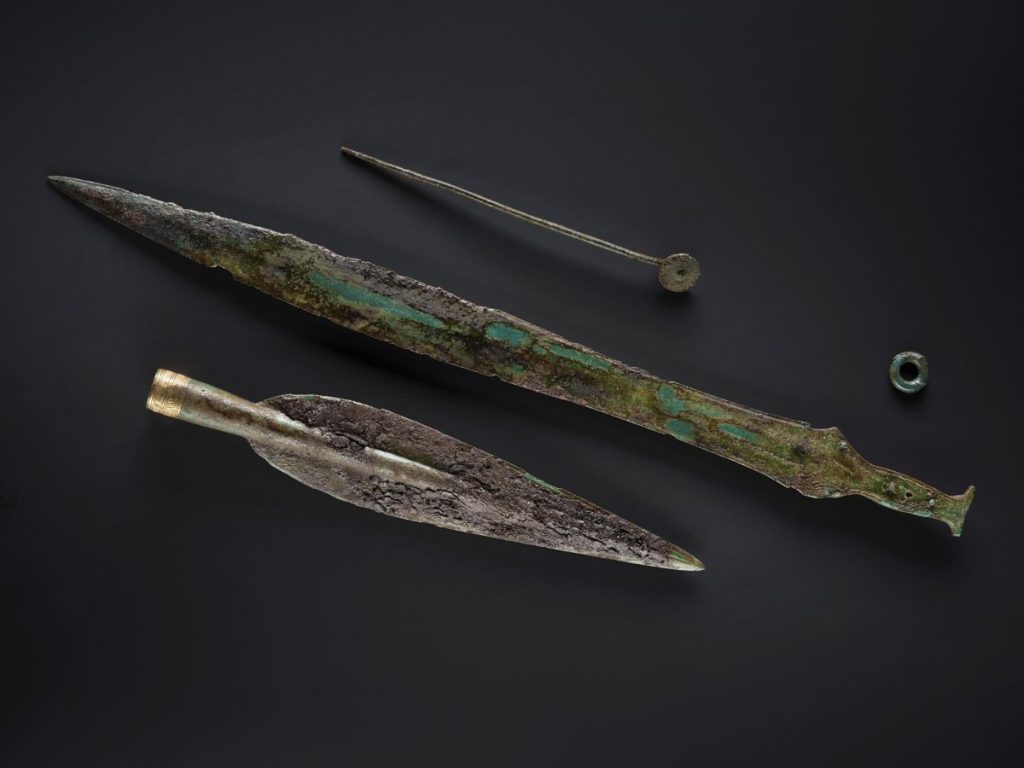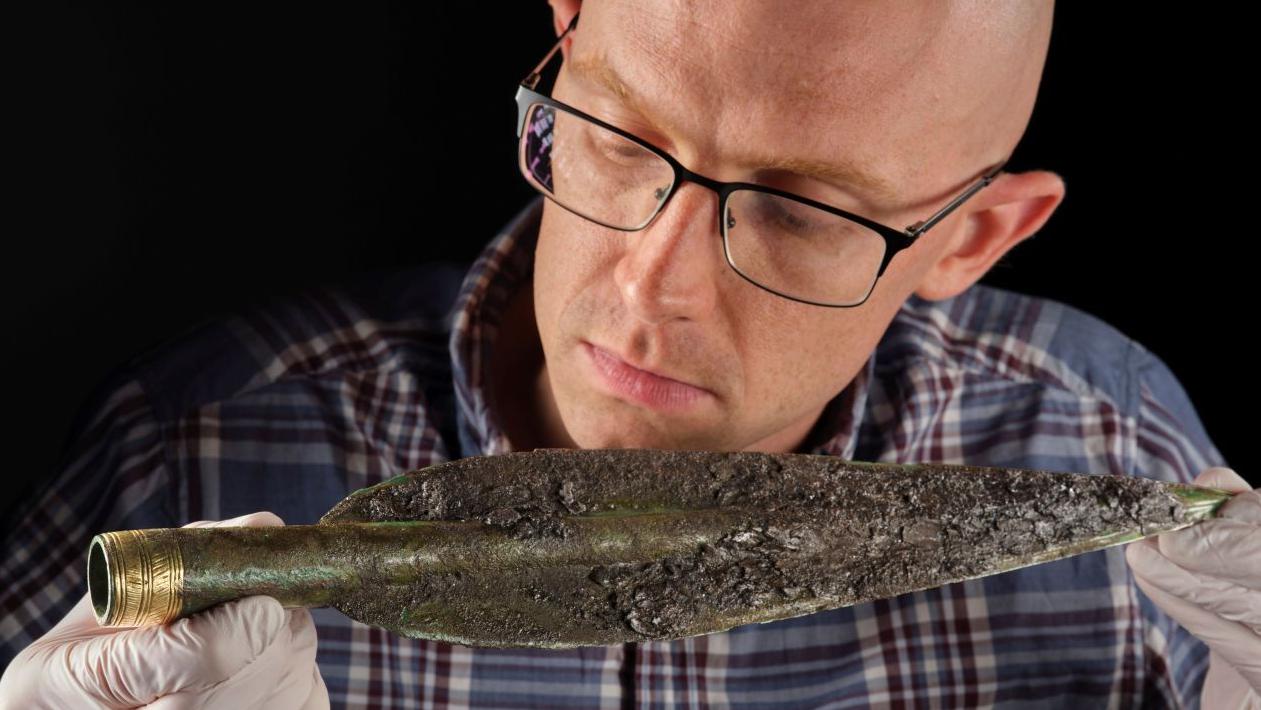Sometimes the most incredible discoveries happen in the most ordinary places.
A Bronze Age hoard found on land meant for football pitches has turned out to be one of Scotland’s most remarkable archaeological discoveries. What started as a routine dig before building new sports facilities has revealed weapons and treasures that belonged to ancient warriors over 3,000 years ago.
The find near Carnoustie in Angus has archaeologists and museum experts buzzing with excitement. This isn’t just any old Bronze Age discovery – it’s something truly special that’s changing how we think about Scotland’s ancient past.
And the best part? You’ll be able to see it for yourself next year when it goes on display for the very first time.
What Makes This Discovery So Special?
When archaeologists talk about a Bronze Age hoard found in Scotland, they’re usually describing a few bronze tools or weapons scattered across a field. But the Carnoustie discovery is different. Very different.
This Bronze Age hoard found by GUARD Archaeology in 2016 includes a spearhead decorated with actual gold – something so rare that only two examples are known from the whole of Scotland. The other one was discovered just 20 kilometres away, which makes you wonder what was so special about this area thousands of years ago.
But that’s not all. The Bronze Age hoard found at the site also contained a bronze sword still sitting in its wooden scabbard. That might not sound like much, but it’s actually the first time archaeologists have ever found a Bronze Age sword in its scabbard in Scotland.
The preservation is mind-blowing. After more than 3,000 years buried in the ground, you can still see traces of the woollen cloth that wrapped the spearhead and the sheepskin that protected the blade.
The Care That Went Into Hiding These Treasures

What really gets experts excited about this Bronze Age hoard found near Carnoustie is how carefully everything was buried. These weren’t weapons quickly hidden during a battle or tools accidentally dropped and forgotten.
Someone took enormous care with these precious objects. The sword was wrapped in a woven wool garment and fastened with a decorative pin. The spearhead blade was carefully covered in sheepskin, while the gold-decorated socket was wrapped in fine woollen cloth.
Dr Matthew Knight from National Museums Scotland can barely contain his excitement. “The Carnoustie Hoard is a remarkable discovery,” he says. “This is the first time we’ve encountered weapons buried at a settlement where people lived.”
The Bronze Age hoard found at Carnoustie was deliberately placed near a roundhouse where people actually lived – not hidden away in some remote spot. That tells us these weapons weren’t just tools of war, but precious possessions with deep meaning for the people who owned them.
A Window Into Ancient Scottish Life
Before this Bronze Age hoard found its way into archaeologists’ hands, we had a pretty basic understanding of what life was like in Bronze Age Scotland. People lived in roundhouses, they farmed, they made bronze tools and weapons. Pretty straightforward stuff.
But the Carnoustie discovery has completely changed that simple picture.
The gold decoration on the spearhead suggests there were wealthy, powerful people living in this area – a warrior elite who could afford to have their weapons decorated with precious metals. The care taken to wrap and bury these items shows they held massive significance, probably both practical and spiritual.
The Bronze Age hoard found here wasn’t just randomly buried either. It was placed next to a settlement where people lived for centuries, from around 1400 BC to 800 BC. The weapons themselves date from 1120-920 BC, right in the middle of that period.
Signs of Ancient Warfare
Look closely at the sword from this Bronze Age hoard found in Scotland and you’ll see something fascinating – and a bit scary. The blade has clear notches and rebound marks along its edges. This wasn’t some ceremonial weapon that never saw action. This sword was used in real battles.
The spearhead, despite its gold decoration, also shows signs that it might have been used for fighting. Experts have spotted a structural weakness that would have made it vulnerable in combat, but that doesn’t mean it wasn’t a weapon.
These weren’t museum pieces sitting on a shelf. They were working weapons owned by people who knew how to use them and weren’t afraid to do so when needed.
The Bigger Archaeological Picture
The site where this Bronze Age hoard found its final resting place has been significant to people for thousands of years. The Bronze Age settlement was built on top of even older remains – including what’s now known as Scotland’s largest early Neolithic timber hall, dating back to around 4000 BC.
That means people have been drawn to this spot near Carnoustie for over 6,000 years. Something about this location made it special to generations of ancient Scots, from the very first farmers to the Bronze Age warriors who buried their precious weapons here.
The full archaeological excavation uncovered around 650 artifacts spanning nearly 3,000 years of human activity. But it’s the Bronze Age hoard found among all those discoveries that’s captured everyone’s imagination.
What Nearly Happened to These Treasures

Here’s the scary part: this incredible Bronze Age hoard found near Carnoustie almost never saw the light of day. The land was bought by Angus Council specifically to be turned into community football pitches. If it weren’t for regulations requiring archaeological surveys before construction, these priceless artifacts might have been destroyed by diggers and never recovered.
GUARD Archaeology was brought in to do a routine check of the site because earlier work in the area had found some prehistoric remains. Nobody expected to uncover such an important Bronze Age hoard found in what seemed like an unremarkable piece of farmland.
The discovery process took years of careful excavation and even more painstaking conservation work. The organic materials – wood, textiles, leather – had survived for over 3,000 years, but they needed expert care to preserve them for future study.
Coming to a Museum Near You
After years of conservation work, this remarkable Bronze Age hoard found in Scotland will finally go on public display. National Museums Scotland has acquired the entire collection and it’ll be the centerpiece of a new exhibition called “Scotland’s First Warriors” opening on June 27th, 2026.
The exhibition will run until May 17th, 2027, at the National Museum of Scotland in Edinburgh, and admission will be completely free. Alongside the Carnoustie treasure, visitors will see over 250 objects telling the story of warfare and conflict in prehistoric Scotland.
“After hours of painstaking conservation, I can’t wait for visitors to see the hoard for the first time,” says Dr Knight. The Bronze Age hoard found near Carnoustie will be displayed alongside other never-before-seen archaeological discoveries from across Scotland.
What This Means for Our Understanding of Ancient Scotland
This Bronze Age hoard found in Angus is forcing archaeologists to completely rethink what they thought they knew about prehistoric Scotland. Instead of simple farming communities just trying to survive, we’re seeing evidence of sophisticated societies with wealthy elites, long-distance trade networks, and complex social structures.
The gold decoration on the spearhead probably came from Ireland or Wales – showing these Bronze Age communities weren’t isolated but part of wider networks spanning the British Isles. The quality of the craftsmanship rivals anything found elsewhere in Europe from this period.
The Human Story Behind the Discovery
What makes any Bronze Age hoard found particularly fascinating isn’t just the objects themselves, but the human stories they tell. Someone owned these weapons, used them in battle, treasured them enough to wrap them carefully in fine cloth and valuable sheepskin.
When the time came to bury them – whether because their owner died, the settlement was abandoned, or for religious reasons we can’t understand – someone took enormous care to do it properly. These weren’t thrown in a pit and covered with dirt. They were laid to rest with the reverence you’d give to something sacred.
The Bronze Age hoard found at Carnoustie represents not just ancient technology, but ancient people with the same capacity for attachment, reverence, and ceremony that we have today.
Why This Matters Today
In a world where development often destroys archaeological sites before they can be properly investigated, the story of this Bronze Age hoard found in Scotland is a reminder of why proper archaeological surveys matter. These treasures almost disappeared forever under a football pitch.
The discovery also shows how much we still don’t know about our ancestors. Despite centuries of archaeological work in Scotland, this Bronze Age hoard found near Carnoustie has revealed completely new information about how people lived, fought, and thought over 3,000 years ago.
Most importantly, it proves that incredible discoveries are still waiting to be made. You don’t need to travel to Egypt or Greece to find amazing archaeology – sometimes the most remarkable Bronze Age hoard found in recent decades is sitting quietly under a field earmarked for community sports facilities.
When the exhibition opens next year, visitors will get to see not just ancient artifacts, but evidence of sophisticated, complex people who lived full, rich lives in Bronze Age Scotland. And that, perhaps, is the greatest treasure of all.
